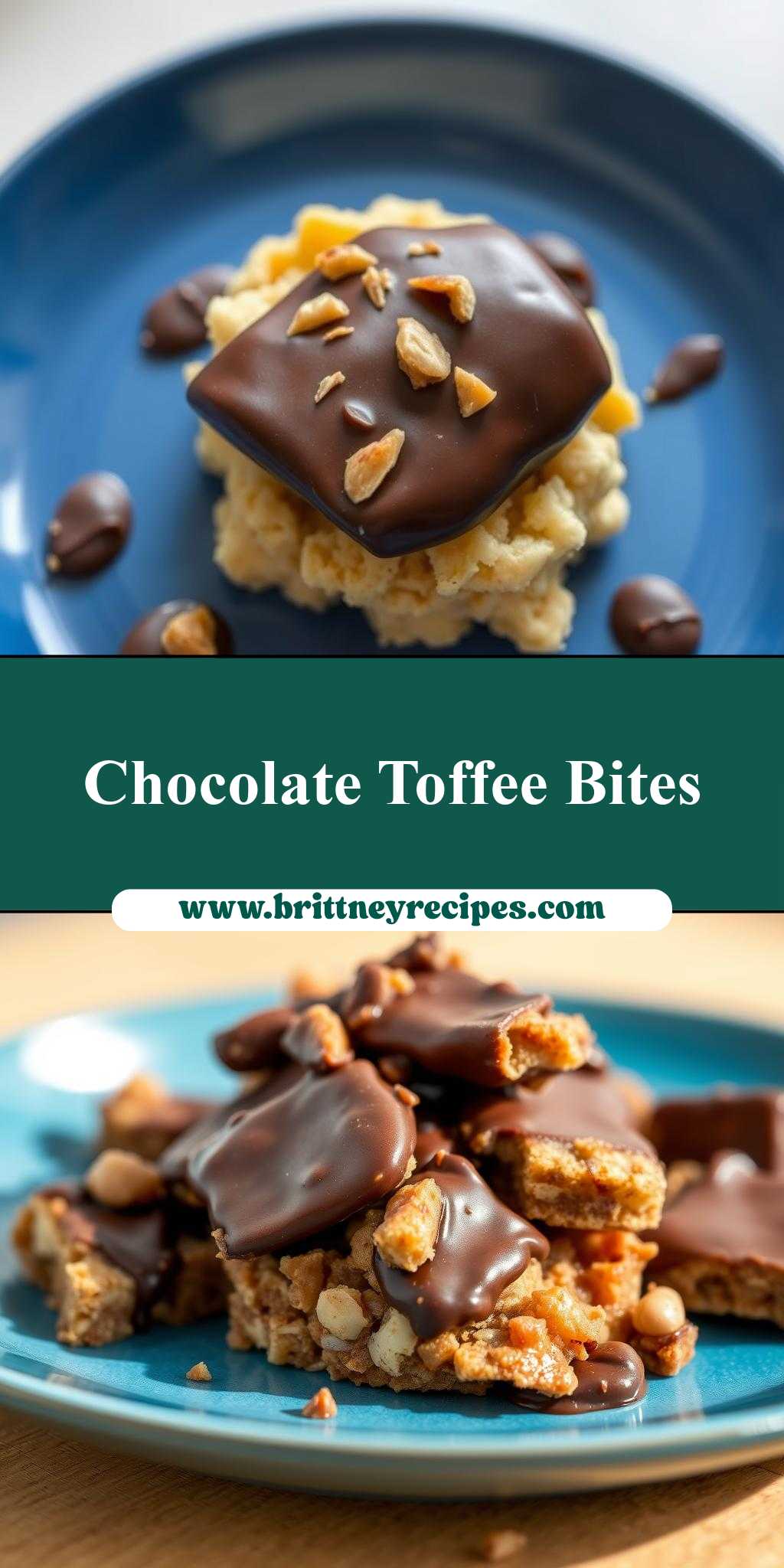What’s the perfect combination of sweet and salty to satisfy your afternoon slump? Rich chocolate paired with crunchy toffee makes for a quick and easy dessert that’s also a homemade favorite, thanks to simple ingredients like melted chocolate and toasted nuts. Save this idea for a indulgent treat to make anytime.
a blue plate topped with chocolate covered toffee
Introduction
Imagine a dish that combines the simplicity of a blue plate with the decadence of chocolate-covered toffee, creating a treat that’s as visually appealing as it is delicious. This recipe is perfect for those looking to impress with minimal effort, using everyday ingredients to create a masterpiece of flavors and textures. The beauty of this dish lies in its ease of preparation, requiring just a few ingredients and some basic kitchen skills. Whether you’re a seasoned chef or a culinary novice, this blue plate topped with chocolate-covered toffee is sure to delight both the eyes and the taste buds.
Why This Works
- Flavor balance and ingredient accessibility: The combination of rich chocolate and crunchy toffee on a simple blue plate creates a harmonious balance of flavors and textures that anyone can achieve with easily accessible ingredients.
- Ease of preparation: This recipe requires minimal cooking and preparation time, making it perfect for last-minute desserts or snacks.
- Impressive results with minimal effort: Despite its simplicity, the presentation and taste of this dish are sure to impress, making it ideal for gatherings or special occasions.
Key Ingredients
The main ingredients for this recipe include high-quality chocolate (preferably dark or milk chocolate, depending on your taste preferences), toffee bits or English toffee bars, and a blue plate for serving. For the chocolate, you can use chocolate chips or chop a chocolate bar into smaller pieces for easier melting. Toffee can be store-bought or homemade, depending on your preference and the time you have available. Practical substitutions include using different types of chocolate or adding nuts, caramel bits, or sea salt to the toffee for added flavor and texture.
Instructions
- Step 1: Begin by preparing your toffee. If using store-bought toffee, skip to the next step. For homemade toffee, combine butter, sugar, and any desired flavorings (like vanilla or sea salt) in a saucepan and heat over medium heat, stirring constantly, until the mixture reaches 300°F on a candy thermometer. Pour onto a greased surface and let cool and harden.
- Step 2: Melt your chocolate. Place the chocolate pieces in a double boiler or in a microwave-safe bowl in 30-second increments, stirring between each interval until smooth. Be careful not to overheat the chocolate.
- Step 3: Cover the toffee with chocolate. Once the toffee is hardened (if making homemade toffee) and the chocolate is melted, dip the toffee pieces into the chocolate, coating them completely. Place the chocolate-covered toffee on a piece of parchment paper or a silicone mat. If using toffee bits, you can also sprinkle them onto the melted chocolate on the parchment paper and let it set.
- Step 4: Final touches and plating. Once the chocolate is set, place the chocolate-covered toffee onto the blue plate. You can arrange the toffee pieces in a pattern or simply pile them onto the plate. Consider adding garnishes like fresh fruit, nuts, or a sprinkle of sea salt to enhance the visual appeal and flavor of the dish.
Handy Tips
- For a smoother chocolate coating, make sure the toffee is completely dry and free of dust or debris before dipping. Also, avoid overheating the chocolate, as this can cause it to seize up or become too thin.
- Consider using different types of chocolate for a varied flavor profile. Dark chocolate pairs well with the deep, caramel flavor of toffee, while milk chocolate adds a sweeter, creamier element.
- To avoid the chocolate-covered toffee becoming too messy or difficult to handle, work in small batches and refrigerate the coated toffee for about 10 minutes to set the chocolate before serving.
Heat Control
If you’re making homemade toffee, heat control is crucial. The ideal temperature for toffee is between 290°F and 300°F. Heating the mixture too high can result in burnt toffee, while not heating it enough can prevent it from setting properly. Use a candy thermometer to monitor the temperature accurately, and remove from heat as soon as it reaches 300°F to prevent overheating.
Crunch Factor
The crunch factor in this dish comes from the toffee, which should be hard and crunchy after cooling and setting. To achieve the perfect crunch, ensure that the toffee reaches the correct temperature during cooking and cools completely before coating with chocolate. If the toffee is chewy or soft, it may not have been cooked to the right temperature or could have been exposed to too much moisture.
Pro Kitchen Tricks
- Tempering the chocolate can give it a professional, glossy finish. This involves heating and cooling the chocolate to a specific temperature to create a stable crystal structure that sets well and has a nice snap when broken.
- Using high-quality ingredients, including fresh and real chocolate and butter, can significantly enhance the flavor and texture of the dish.
- For a fun twist, experiment with different flavors in your toffee, such as adding a teaspoon of espresso powder for a mocha flavor or using flavored extracts like orange or mint.
Storage Tips
- Chocolate-covered toffee is best stored in an airtight container in the refrigerator to keep the chocolate from melting or becoming sticky. It can be stored for up to 5 days.
- For longer storage, consider freezing the toffee before coating it with chocolate. Frozen toffee can be stored for up to 2 months. Simply thaw and coat with chocolate when ready to serve.
- When storing, keep the chocolate-covered toffee away from strong-smelling foods, as chocolate can absorb odors easily.
Gift Packaging Ideas
This dish makes a wonderful gift, especially during holidays or special occasions. Consider packaging the chocolate-covered toffee in decorative jars, gift boxes, or bags tied with a ribbon. You can also add a personal touch by including a handwritten note or a small decorative element that matches the occasion. For a more rustic look, use parchment paper or brown paper bags and tie with twine.
Flavor Variations
- Different spices: Try adding a pinch of cayenne pepper to the toffee for a spicy kick or using cinnamon, nutmeg, or cardamom for a warmer, more aromatic flavor.
- Creative toppings: In addition to nuts or sea salt, consider topping your chocolate-covered toffee with dried cranberries, cherries, or other fruits for a sweet and tangy contrast.
- Ingredient swaps: Swap out the toffee for other crunchy ingredients like peanut brittle, candy pieces, or even cookie crumbs for a different texture and flavor profile.
Troubleshooting
- Texture problems: If your toffee turns out too chewy, it may not have been cooked to the correct temperature. If it’s too hard, it could have been overcooked.
- Ingredient replacements: If you don’t have toffee, consider using other crunchy candies or nuts as a substitute. For chocolate, you can use chocolate chips, chocolate bars, or even candy melts in a pinch.
- Over/undercooking signs: Keep an eye on your toffee while it’s cooking, as the mixture can quickly go from perfectly cooked to burnt. If making homemade toffee, remove it from the heat as soon as it reaches 300°F.
FAQs
- Can I freeze it? Yes, you can freeze the toffee before coating it with chocolate. Simply place the cooled toffee in an airtight container or freezer bag and store in the freezer for up to 2 months. Thaw and coat with chocolate when ready to serve.
- Is it gluten-free? This recipe is naturally gluten-free, making it a great option for those with gluten intolerance or sensitivity. However, always check the ingredients of your chocolate and any additives to ensure they are gluten-free.
- Can I double the recipe? Yes, you can easily double or triple this recipe to make more chocolate-covered toffee. Just be sure to adjust the cooking time slightly if making a larger batch of homemade toffee.
Conclusion
Creating a blue plate topped with chocolate-covered toffee is a fun and rewarding project that combines simplicity with elegance. With its rich, deep flavors and visually appealing presentation, this dish is perfect for special occasions or as a unique dessert for any gathering. Don’t be afraid to experiment with different flavors and toppings to make the recipe your own, and enjoy the process of creating something truly special and delicious.

